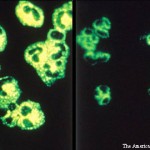A Doctor Becomes a Patient

Dr. Rahbar
Patients peppered Dr. Gardner with questions about lung symptoms and what they might mean. The topic was revisited over lunch, when attendees heard the story of Habib Rahbar, MD, an associate professor and clinical director of breast imaging at the Seattle Cancer Care Alliance who was diagnosed with vasculitis in 2018.
Dr. Rahbar first experienced “the most excruciating pain I’ve ever experienced in my right shoulder” after a snowball fight with his three sons and au pair. Despite his fitness, Dr. Rahbar chalked up the sharp, pulsing pain to old age. Initially, the pain faded in the mornings and reappeared in the evenings. Even as it become harder to bear and was joined by pain in other joints—his toes, knees and elbows—he tried to explain it away.
Fortunately, the resident who first saw him didn’t and ordered lab tests to investigate. “Thank goodness she did,” Dr. Rahbar said. An initial blood test revealed an abnormally high eosinophil count and a follow-up showed similarly high ANCA counts. A rheumatology team took over and found groundglass opacity in his lungs, suggestive of inflammation or DAH, and early signs of kidney disease in his urine. “It was a pretty sobering weekend,” he recalled.
A bronchoscopy helped finalize the diagnosis: The doctors pulled “cups of blood” from his lungs and confirmed the presence of DAH, he said. He was diagnosed with PR3-ANCA-associated vasculitis. In contrast to the dire prognoses he remembered from medical school, though, his rheumatologist told him he had every reason to be optimistic. “And boy, was he right,” Dr. Rahbar said.
After an initial treatment with high-dose steroids, two rounds of rituximab knocked his vasculitis into remission. “The amazing thing is here I am, and nobody would ever guess that I have vasculitis,” he said. For him, he said, rituximab has been a “miracle drug.” Dr. Rahbar said he was sharing his story to let others know that it’s okay to be scared. “It’s also okay to be optimistic,” he added. “We live in a time where the progress that we’re making with this treatment is incredible.”
While the audience expressed appreciation for Dr. Rahbar’s story and his sunny outlook, several patients shared a range of frustrations and made clear that not everyone has been as fortunate. One woman told him how she had recently been diagnosed with GPA after experiencing unexplained fatigue as her only major symptom. She has a good doctor, she said. “But it taught me that you really have to pay attention to your body. If we hadn’t pushed on how tired I was, I could have gone into dialysis for kidney issues.” She could have easily ignored it instead of pushing back and saying, “This isn’t right,” she said.
Another said she has had to be her own advocate and navigate the system while insiders like Dr. Rahbar have better avenues and access. Multiple people in the crowd nodded in agreement. So how can lay people impress upon doctors the importance of taking their concerns seriously, she asked? A third patient said it had taken six-and-a-half years for her to be properly diagnosed with vasculitis, while a fourth described having to use a spreadsheet to manage her own complicated care after a recent diagnosis of GCA.
Dr. Rahbar said he had empathy for those whose diagnosis was unnecessarily delayed and agreed that he had more advantages as a patient and was likely seen faster and diagnosed earlier despite his attempts to ignore his own symptoms. Primary care physicians need to know enough to consider vasculitis as a possibility among their patients, he said. “We need to continue to really emphasize primary care and make sure that some of the smartest doctors who want to be part of primary care go into it.”
He urged the audience to ask questions and seek out second opinions if they weren’t satisfied with their doctors’ initial assessments. “Patients know sometimes when their body isn’t quite right,” he said. “We’re not perfect. We’re humans, we make mistakes.”


